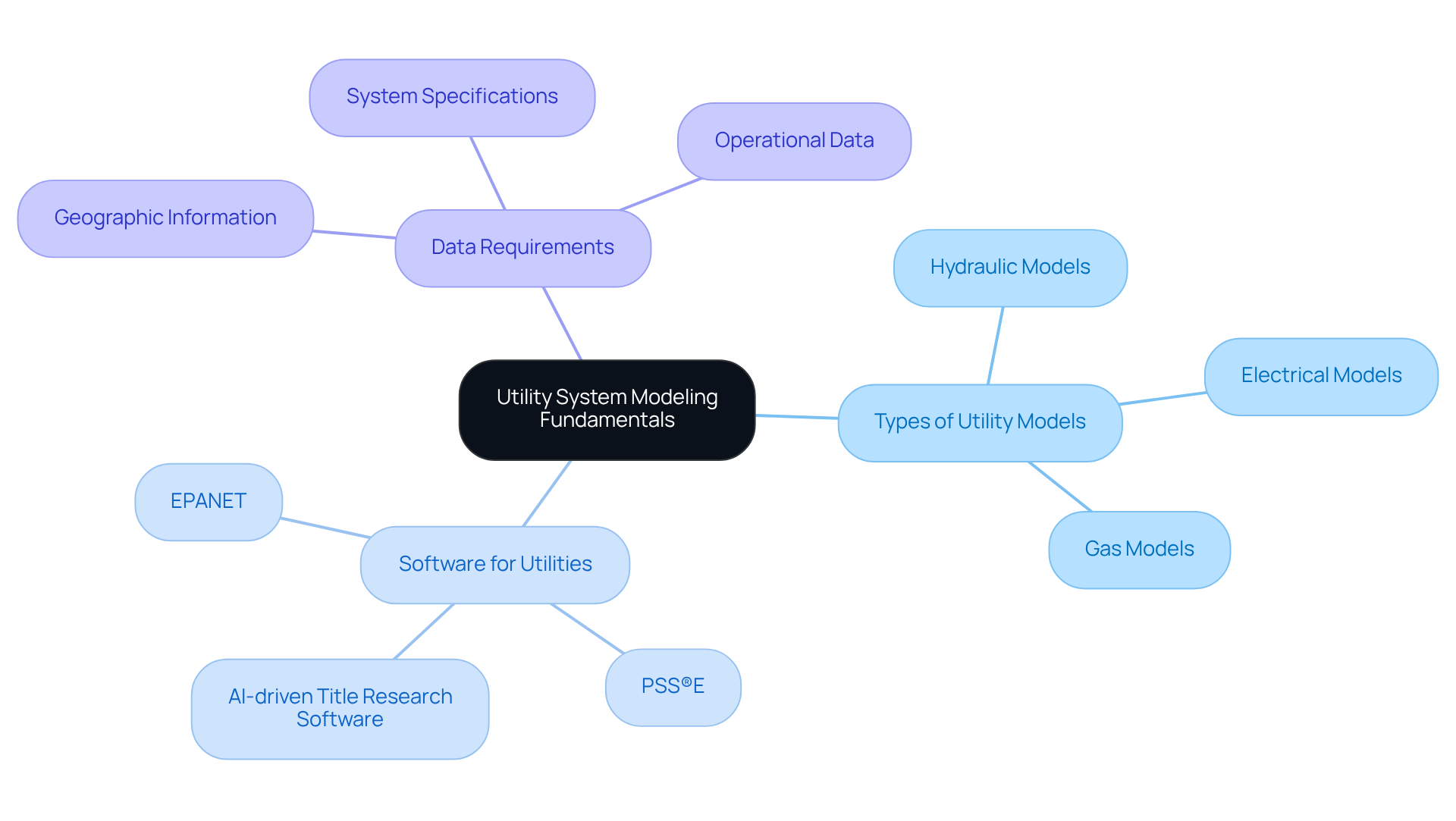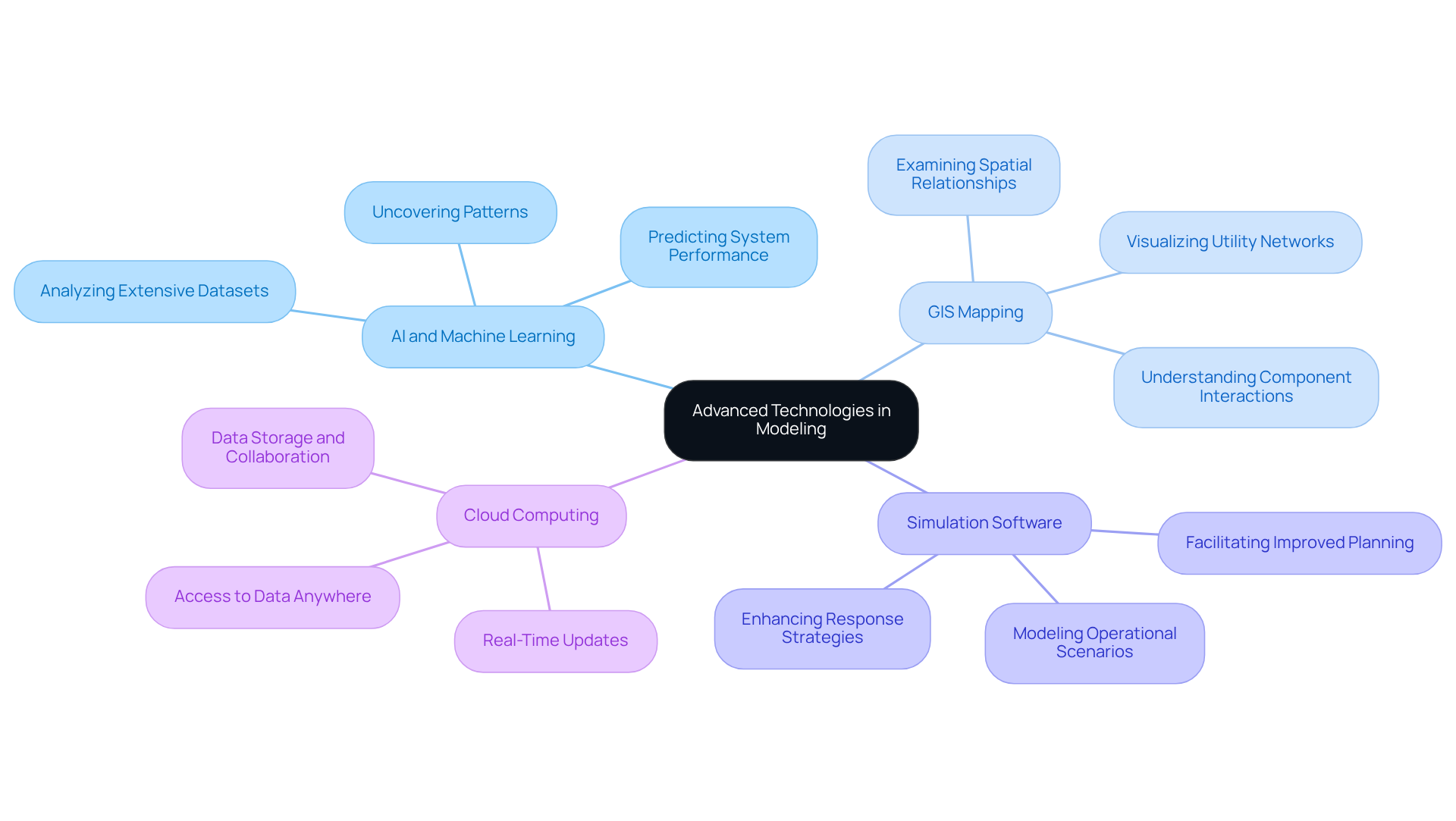Overview
This article presents a comprehensive approach to mastering advanced utility system modeling. It emphasizes the critical importance of:
- Understanding utility fundamentals
- Assessing current infrastructure
- Incorporating advanced technologies
- Effectively engaging stakeholders
Each step is supported by practical examples and insights, demonstrating that a thorough evaluation combined with innovative tools can lead to more efficient and resilient utility systems.
Introduction
Advanced utility system modeling is rapidly evolving, driven by the pressing need for efficient management of essential services such as water, electricity, and gas. This guide lays out a clear pathway for mastering this intricate field, underscoring the critical importance of foundational knowledge, data accuracy, and stakeholder engagement.
As advanced technologies become increasingly integrated and community demands grow, professionals must consider:
- How can their models not only meet current standards but also anticipate future challenges?
Understand Utility System Modeling Fundamentals
Advanced utility system modeling involves creating a digital representation of service networks that encompass water, electricity, and gas systems. To effectively master this field, it is essential to familiarize yourself with key concepts such as:
-
Types of Utility Models: Recognize the distinctions among hydraulic models, electrical models, and gas models. Each type serves a specific purpose and necessitates unique data inputs. According to information from WIPO, there have been 33 model applications globally from 1990 to 2022, underscoring the growing importance of these models across various sectors.
-
Software for Utilities: Explore the diverse software options available for utility analysis, such as EPANET for water networks and PSS®E for electrical networks. Each tool possesses its strengths and is tailored for different analytical needs. Harbinger Land utilizes advanced technology, including AI-driven title research software, to enhance efficiency in their creation processes.
-
Data Requirements: Determine the types of data essential for effective analysis, including geographic information, system specifications, and operational data. Reliable models hinge on accurate data. As Dr. Horst Stipp, EVP of Research & Innovation at the Advertising Research Foundation, emphasized, "Grasping the subtleties of data in functional analysis is crucial for impactful decision-making."
By mastering these fundamentals, you will be well-equipped to advance to advanced utility system modeling and other more sophisticated modeling techniques in subsequent steps.

Assess Current Utility Infrastructure and Needs
To effectively assess your current utility infrastructure, it is essential to follow these steps:
- Conduct a Field Survey: Begin by visiting utility sites to gather firsthand information regarding the existing infrastructure. Record the condition, capacity, and arrangement of the setups, as this direct observation is crucial for precise evaluations. For instance, the City of Cincinnati reported that structuring procurement via a municipal lease allowed them to experience immediate cost parity compared to traditional vehicles, emphasizing the importance of thorough field assessments.
- Collect Data: It is vital to gather historical performance data, maintenance records, and any existing models. This data provides insights into how the frameworks have operated over time, enabling a more informed analysis. According to a report by Avista Corp., over 53,000 charging sessions were completed and analyzed, showcasing the value of comprehensive data collection in understanding system performance.
- Identify Stakeholder Needs: Engage with stakeholders, including service operators and community members, to understand their needs and concerns regarding the current infrastructure. Their input is essential for ensuring that the models developed address real-world challenges. As noted by the City of Loveland, interacting with community members can significantly improve the efficiency of resource evaluations.
- Analyze Gaps: Compare the existing infrastructure with best practices and regulatory standards to identify deficiencies that need to be addressed in your analysis efforts. This step is crucial for aligning your infrastructure with industry standards and enhancing overall efficiency. Current trends indicate that many cities are evolving their procurement strategies to incorporate leasing options, which can reduce upfront costs and improve the feasibility of infrastructure upgrades.
This thorough evaluation establishes a strong foundation for advanced utility system modeling, which effectively addresses the requirements of all parties involved, ensuring a more resilient and efficient infrastructure.

Incorporate Advanced Technologies in Modeling
Incorporating advanced utility system modeling technologies is essential for enhancing efficiency and effectiveness. Consider the following technologies:
- AI and Machine Learning: Implement AI algorithms to analyze extensive datasets and predict system performance across various scenarios. Machine learning can uncover patterns that traditional methods may overlook.
- GIS Mapping: Leverage Geographic Information Systems (GIS) to visualize utility networks and examine spatial relationships. GIS enhances your understanding of how different components interact within the system.
- Simulation Software: Employ simulation tools to model various operational scenarios, such as peak demand or emergency situations. This approach facilitates improved planning and response strategies.
- Cloud Computing: Utilize cloud-based platforms for data storage and collaboration, allowing for real-time updates and access to data from anywhere.
By integrating these advanced technologies, you can enhance advanced utility system modeling to create more resilient and dynamic service models that effectively meet your project's requirements.

Engage Stakeholders and Negotiate Effectively
To effectively engage stakeholders and negotiate during the utility modeling process, it is essential to follow a structured approach:
- Identify Key Stakeholders: Begin by determining who the key stakeholders are, including utility operators, regulatory agencies, and community representatives. Recognizing these individuals is crucial for effective engagement.
- Establish Communication Channels: Create open lines of communication to keep stakeholders informed and involved throughout the development process. Regular updates foster trust and collaboration, ensuring stakeholders feel valued and engaged.
- Present Findings: Share the results of your assessments and simulations with stakeholders, emphasizing how the models address their needs and concerns. This step is vital for ensuring that stakeholders recognize the importance of the analytical process and its impact on their interests.
- Negotiate Resources: Be prepared to negotiate for necessary resources, such as funding or data access. Clearly articulate the advantages of your analytical efforts, supported by GIS insights, to secure stakeholder support.
By effectively engaging stakeholders and negotiating, you can ensure that your utility system modeling efforts are not only supported but also aligned with the broader goals of the project.

Conclusion
Mastering advanced utility system modeling is crucial for tackling the complexities inherent in managing essential services such as water, electricity, and gas. Grasping fundamental concepts, assessing current infrastructure needs, incorporating cutting-edge technologies, and effectively engaging stakeholders are pivotal for enhancing the resilience and efficiency of utility systems.
This article presents a structured approach to these key areas, emphasizing the importance of understanding various utility models, the necessity of accurate data, and the role of advanced technologies like AI and GIS. Furthermore, it highlights stakeholder engagement and negotiation as critical components in developing models that satisfy both current and future demands.
As the landscape of utility management evolves, adopting these strategies will not only bolster operational efficiency but also foster collaboration among stakeholders. By proactively addressing infrastructure needs and harnessing technology, professionals can ensure that utility systems are equipped to meet the challenges of tomorrow, ultimately contributing to more sustainable and effective service delivery.
Frequently Asked Questions
What is advanced utility system modeling?
Advanced utility system modeling involves creating a digital representation of service networks that include water, electricity, and gas systems.
What are the main types of utility models?
The main types of utility models are hydraulic models, electrical models, and gas models. Each type serves a specific purpose and requires unique data inputs.
How many utility model applications have been made globally from 1990 to 2022?
There have been 33 utility model applications globally from 1990 to 2022, highlighting the increasing importance of these models across various sectors.
What software options are available for utility analysis?
Software options for utility analysis include EPANET for water networks and PSS®E for electrical networks. Each software has its strengths and is tailored for different analytical needs.
What technology does Harbinger Land use in its processes?
Harbinger Land utilizes advanced technology, including AI-driven title research software, to enhance efficiency in their creation processes.
What types of data are essential for effective utility modeling?
Essential data for effective utility modeling includes geographic information, system specifications, and operational data. Accurate data is crucial for reliable models.
Why is understanding data important in utility system modeling?
Understanding the subtleties of data in functional analysis is crucial for impactful decision-making, as emphasized by Dr. Horst Stipp, EVP of Research & Innovation at the Advertising Research Foundation.
List of Sources
- Understand Utility System Modeling Fundamentals
- Number of utility model applications worldwide| Statista (https://statista.com/statistics/257640/number-of-utility-model-applications-worldwide)
- Assess Current Utility Infrastructure and Needs
- The Las Vegas Valley Water District Works Around the Clock to Protect its Community | Echologics (https://echologics.com/resources/case_studies/las-vegas-valley-water-district-works-around-clock-protect-its-community)
- EV Case Studies (https://avista.chooseev.com/commercial/case_studies)




